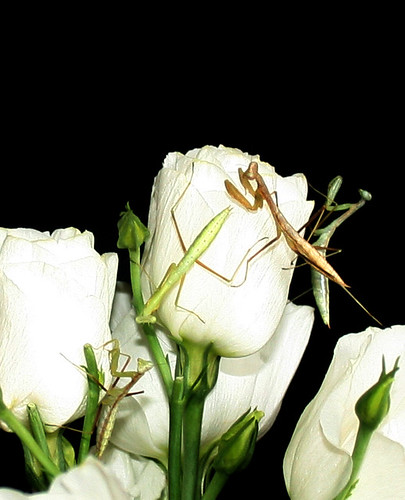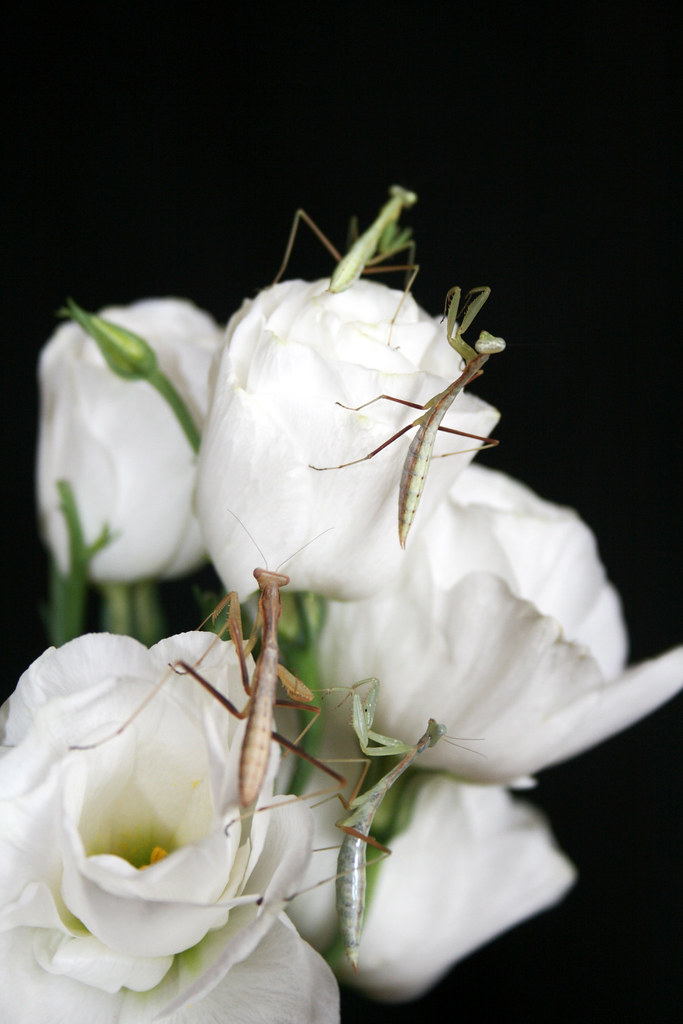You are using an out of date browser. It may not display this or other websites correctly.
You should upgrade or use an alternative browser.
You should upgrade or use an alternative browser.
Alalomantis muta IGM 132
- Thread starter tier
- Start date

Help Support Mantidforum:
This site may earn a commission from merchant affiliate
links, including eBay, Amazon, and others.
idolomantis
Well-known member
Very nice looking mantids there, tier 
revmdn
Well-known member
Cool.
They almost look like they have a white "sheen" to their abdomen. Do they appear this way in real life?
Thanks for letting us see.
Thanks for letting us see.

$13.99 ($223.84 / lb)
Surmen Legacy Freshly Started Wingless Drosophila Melanogaster Fruit Fly Culture
Surmen Legacy

$18.99 ($2.12 / Ounce)
Josh's Frogs Producing Wingless Drosophila Melanogaster Fruit Fly Culture
Josh's Frogs

$13.99 ($0.44 / Ounce)
$16.99 ($0.53 / Ounce)
Fresh Fruit Fly Culture (Drosophila Hydei) - Praying Mantis Mantid Frog Lizard Food - 32oz Cup
Surmen Legacy

$11.74 ($0.02 / Count)
Predator Foods Bulk Live Mealworms - 500 Count (Medium - 0.5")
Predator Foods

$16.99 ($16.99 / Count)
Josh's Frogs Freshly Started Flightless Drosophila Hydei Fruit Fly Culture
Josh's Frogs

$12.53
Butterfly Breeding Net, Folding Butterfly Habitat Cage White Butterfly Mesh Cage for Kid Garden Science Education Tool 40x40x60cm
enshishiqiannanwangluoyouxiangongsi

$14.00
$89.85
Praying Mantis Egg Case with Hatching Habitat Cup - 2 Praying Mantids Egg Cases
NaturesGoodGuys

$3.19 ($42.53 / lb)
$6.09 ($81.20 / lb)
Fluker's Gourmet Canned Food for Reptiles, Fish, Birds and Small Animals, Black, Mealworms 1.23 Ounce (Pack of 1)
Amazon.com

$39.95 ($1.25 / Ounce)
Creation Cultivated 32oz Fruit Fly Culture - Live Feeder Insects for Praying Mantis, Jumping Spiders, Geckos, Lizards, Dart Frogs (Drosophila Hydei Flightless)
Creation Cultivated

$36.00
Carolina Mantis Egg Hatching Kit - 2 Eggs Fresh for The Season
HeZeXinHaoYunWangLuoXiaoShouGongSi
Hi
Thanks "idolOmantis" and "revmdn" , but I have not invented them
Thanks "Gurd", my mate. I dont know. All I know is Interest Group Mantodea Number 132 is Alalomantis muta, brought to germany last year. I think there is only me and one other person, also a member of this forum, breeding them. This member gave some larvae to me. It was determined using adult males and females as far as I know, and it was determind here in germany. So it should be Alalomantis muta. I have no further information on A. coxalis. I neither know where it came from or who introduced it to the hobby, nor I know who determined it. All I know is that you guys in UK seem to be the only ones keeping it. I don't think it's the same tribe I am keeping, because I dont think anybony else than me and the member who gave this species to me is keeping them. So I don't know what you have. Maybe it's something else, or maybe it's the same, but I guess it is another tribe at least. You know what you have to do: It's the same as usual: Send some adult speciemen to Christian.
But, Gurd, for you, I will take some time and translate what the "Ehrmann 2002, Mantodea - Gottesanbeterinnen der Welt" says concerning the differences in this two species: Be aware that this is the general differences of this two species, what are not necessarily the differences between my A. muta and your W. hatever:
A. coxalis was described by Saussure & Zehntner in 1895. It is located in Congo, Uganda and two other african states I don't know.
A. muta was described by Wood-Mason in 1882. It has a wider range of distribution, inhabiting Angola, Gabun, Cameroon, Congo, Uganda and another african state.
Anyway, Ehrmann says that all species of Alalomantis are always green, but I corrected this fiction with my pictures. This is at least prooven for larvae now. As far as Ehrmann says, Gurd, this two species are the only valid ones of the genus Alalomantis.
Thanks "Katnapper" for your interest. Although my pictures are not very good and altered with photoshop, you seem to be a good observer. It's more a turbidity than a sheen. First I thought this white trurbidity occures after molting (like freshly hatched or freshly molted larvae seem to be more white than usal), but they really have this white sheen or turbidity. The green larvae as well as the brown ones.
regards,
the parasitologist
Thanks "idolOmantis" and "revmdn" , but I have not invented them
Thanks "Gurd", my mate. I dont know. All I know is Interest Group Mantodea Number 132 is Alalomantis muta, brought to germany last year. I think there is only me and one other person, also a member of this forum, breeding them. This member gave some larvae to me. It was determined using adult males and females as far as I know, and it was determind here in germany. So it should be Alalomantis muta. I have no further information on A. coxalis. I neither know where it came from or who introduced it to the hobby, nor I know who determined it. All I know is that you guys in UK seem to be the only ones keeping it. I don't think it's the same tribe I am keeping, because I dont think anybony else than me and the member who gave this species to me is keeping them. So I don't know what you have. Maybe it's something else, or maybe it's the same, but I guess it is another tribe at least. You know what you have to do: It's the same as usual: Send some adult speciemen to Christian.
But, Gurd, for you, I will take some time and translate what the "Ehrmann 2002, Mantodea - Gottesanbeterinnen der Welt" says concerning the differences in this two species: Be aware that this is the general differences of this two species, what are not necessarily the differences between my A. muta and your W. hatever:
A. coxalis was described by Saussure & Zehntner in 1895. It is located in Congo, Uganda and two other african states I don't know.
A. muta was described by Wood-Mason in 1882. It has a wider range of distribution, inhabiting Angola, Gabun, Cameroon, Congo, Uganda and another african state.
Anyway, Ehrmann says that all species of Alalomantis are always green, but I corrected this fiction with my pictures. This is at least prooven for larvae now. As far as Ehrmann says, Gurd, this two species are the only valid ones of the genus Alalomantis.
Thanks "Katnapper" for your interest. Although my pictures are not very good and altered with photoshop, you seem to be a good observer. It's more a turbidity than a sheen. First I thought this white trurbidity occures after molting (like freshly hatched or freshly molted larvae seem to be more white than usal), but they really have this white sheen or turbidity. The green larvae as well as the brown ones.
regards,
the parasitologist
Last edited by a moderator:
Interesting, Tier... thank you. And best of luck with breeding them. 
Thanks for the information.
They were introduced by Graham Smith and collected from Congo as I understand also explains the common name given to the over here the Congo green.
I can also add to the fiction of Alalomantis being only green as I know a couple of people with brown morphs of A.coxalis, mine are all green tho.
Some dead speciemens will find their way to Christian for clarification
They were introduced by Graham Smith and collected from Congo as I understand also explains the common name given to the over here the Congo green.
I can also add to the fiction of Alalomantis being only green as I know a couple of people with brown morphs of A.coxalis, mine are all green tho.
Some dead speciemens will find their way to Christian for clarification
Thanks, but I prefer the word L-word. For a lot of reasons...hmm we call the developing mantids nymphs larvea is not part of the mantis life cycle
Last edited by a moderator:
HiThey were introduced by Graham Smith and collected from Congo
Ahh, see, and mine are from Cameroon.
regards
ismart
Well-known member
Very cool! B)
leviatan
Well-known member
Beautiful species!
The inner femur appears to have some black markings with white circular spots. Is this correct? It is very striking... I'd love to see them in person!  In one of the pics the mantis almost seems to have a "sultry" look to its face. Beautiful.
In one of the pics the mantis almost seems to have a "sultry" look to its face. Beautiful. 
planetq
Well-known member
Really pretty mantises.
Hello
Finally the first larvae are adult. I think "brancsikia" did not post a picture of an adult of the last generation here in the forum, so I now proudly present the first.




The male has nice yellow wings, while the female is standard green.
Thanks to all for their interest and comments.
There are two white resp. yellow marks in a black zone and a third yellow or white mark next to this black zone, yes. But they are not really circular and differ in size. The adults have dark marks on their wings, but they are hard to see.
And yes, maybe they sell better then Sphodromantis, as nobody has any Alalomantis. But all in all, they are just another medium-sized, standad green mantis. I will find out how they sell soon ;-)
regards
Finally the first larvae are adult. I think "brancsikia" did not post a picture of an adult of the last generation here in the forum, so I now proudly present the first.




The male has nice yellow wings, while the female is standard green.
Thanks to all for their interest and comments.
There are two white resp. yellow marks in a black zone and a third yellow or white mark next to this black zone, yes. But they are not really circular and differ in size. The adults have dark marks on their wings, but they are hard to see.
And yes, maybe they sell better then Sphodromantis, as nobody has any Alalomantis. But all in all, they are just another medium-sized, standad green mantis. I will find out how they sell soon ;-)
regards
Last edited by a moderator:















































